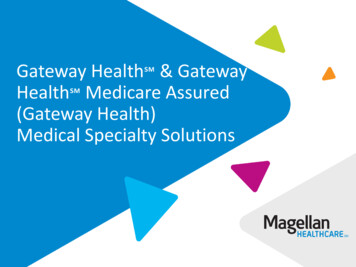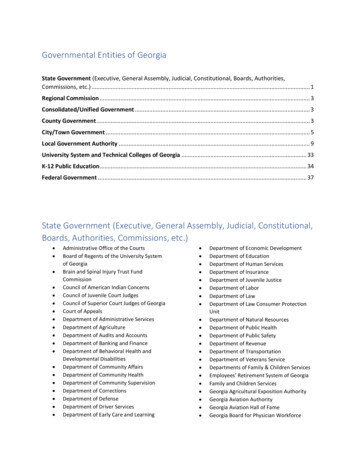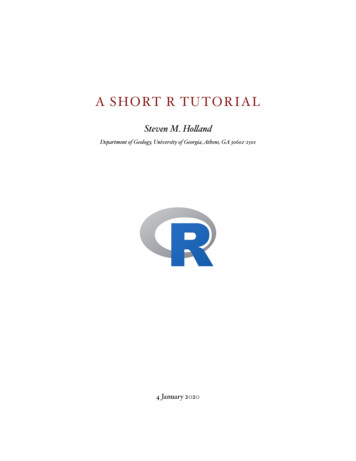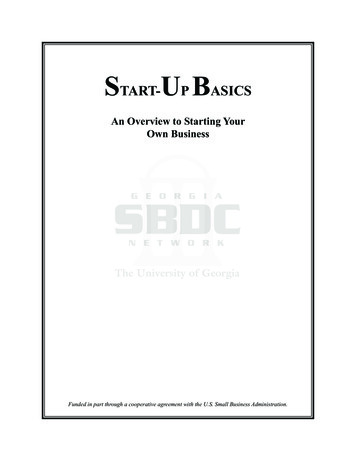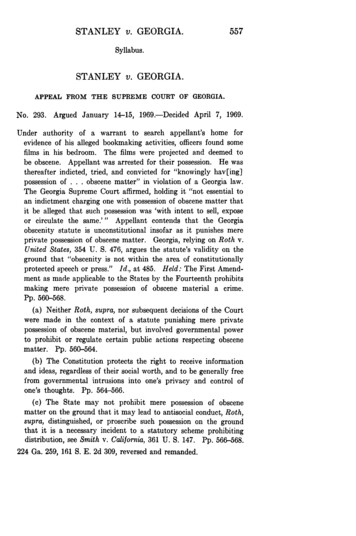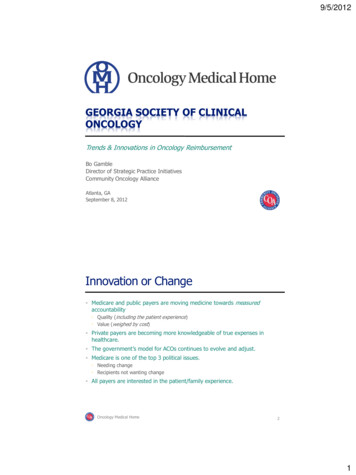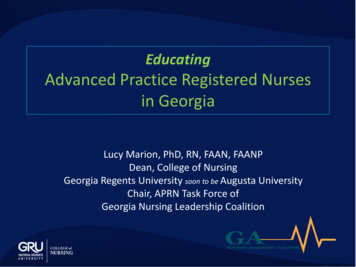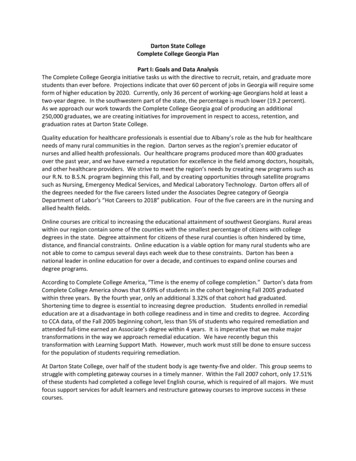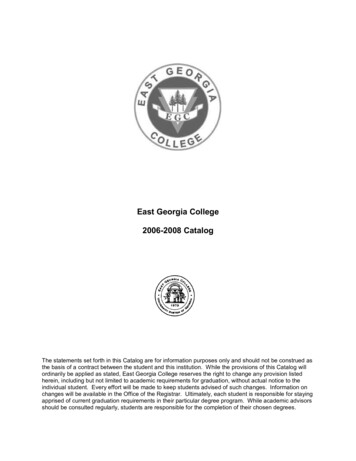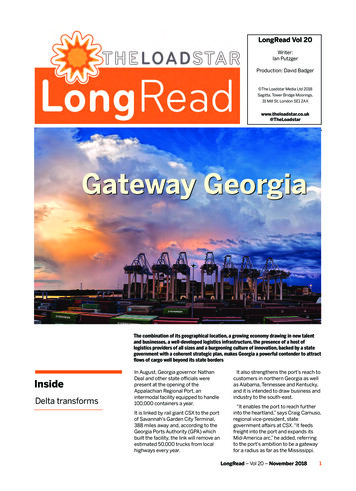
Transcription
GeorgiaHR.qxp Layout 1 06/11/2018 15:01 Page 1LongRead Vol 20Writer:Ian PutzgerProduction: David Badger The Loadstar Media Ltd 2018Sagitta, Tower Bridge Moorings,31 Mill St, London SE1 2AXwww.theloadstar.co.uk@TheLoadstarGateway GeorgiaThe combination of its geographical location, a growing economy drawing in new talentand businesses, a well-developed logistics infrastructure, the presence of a host oflogistics providers of all sizes and a burgeoning culture of innovation, backed by a stategovernment with a coherent strategic plan, makes Georgia a powerful contender to attractflows of cargo well beyond its state bordersInsideDelta transformsIn August, Georgia governor NathanDeal and other state officials werepresent at the opening of theAppalachian Regional Port, anintermodal facility equipped to handle100,000 containers a year.It is linked by rail giant CSX to the portof Savannah’s Garden City Terminal,388 miles away and, according to theGeorgia Ports Authority (GPA) whichbuilt the facility, the link will remove anestimated 50,000 trucks from localhighways every year.It also strengthens the port’s reach tocustomers in northern Georgia as wellas Alabama, Tennessee and Kentucky,and it is intended to draw business andindustry to the south-east.“It enables the port to reach furtherinto the heartland,” says Craig Camuso,regional vice-president, stategovernment affairs at CSX. “It feedsfreight into the port and expands itsMid-America arc,” he added, referringto the port’s ambition to be a gatewayfor a radius as far as the Mississippi.LongRead – Vol 20 – November 20181
GeorgiaHR.qxp Layout 1 06/11/2018 15:01 Page 2“The port of Savannah is poised tocapture new rail cargo across the state,the south-east and well into theAmerican Midwest,” adds GPAexecutive director Griff Lynch.Atlanta-based American GlobalLogistics has pursued a similartrajectory since its inception in 2007,expanding its footprint beyond thestate border. “Our business has grownfrom regional to truly internationaloperations,” says chairman and CEOJon Slangerup, previously CEO of theport of Long Beach.State involvementThe governor’s presence at theopening of the intermodal facilityreflects the close involvement ofGeorgia’s administration with thislogistical expansion.“Logistics is a core competency thatthe state is promoting,” says CathyMorrow Roberson, founder and headanalyst of Logistics Trends & Insights.Markham notes.Since 2011, throughput has grown ata compound annual rate of 4.5%, toestablish Savannah as the secondbusiest port on the east coast and thefourth-largest in the US. The upwardmomentum has kept a brisk rate,outpacing all other major US ports.Savannah has handled over 300,000teu in each of the last 22 months. Inthe financial year ended June 30, itrecorded 4.2 million teu, an increase of8% over the previous year’sthroughput. Intermodal rail lifts rose16.1% during the period.The expansion of the Suez Canal hasbeen a major catalyst for Savannah’srapid growth. While this has brought asurge in imports from Asia, it has notcreated an imbalance in traffic flows.Imports account for 48% of the port’svolume, notes Sandy Lake, associatedirector of the Center of Innovation forLogistics.Logistics is also a key focus at theGeorgia Department of EconomicDevelopment, the state’s sales andmarketing arm and the lead agency forattracting new business investment.Matt Markham, director of thedepartment’s Center of Innovation forLogistics, points out that 80% of theUS market is within two-days’ truckingor a two-hour flight.“The administration has done aphenomenal job in creating anenvironment that is conducive forgrowth and in establishing theinfrastructure for logistics andtransportation,” says Albert Saphir,president of logistics consultancy ABSConsulting. One aspect that hashelped develop a focused strategy isthe absence of competition betweenports in the state, he adds.“You have Brunswick for ro-ro cargo,but for containers there is noalternative to Savannah. Florida ismore fragmented. The ports there arehighly competitive, so the state can’tfocus on one major gateway. And it’sthe same with the airports,” he says.“The port works hand in hand withstate officials, because the stateunderstands that the economic enginefor the state is that port,” says CSX’sCamuso, adding that its throughput isprojected to grow about 60% over thenext decade.The port of Savannah has beenpivotal for Georgia’s growth in logistics.Maritime trade contributes 44bn tothe state’s GDP, 8% of its total. Itslocation gives it an advantage to reachmarkets as far as the Midwest,2“The port works hand in handwith state officials, becausethe state understands that theeconomic engine for the stateis that port”Craig Camuso, regional VPstate government affairs at CSXFor American Global Logistics thechange has brought a significanttransformation, though.“As Savannah became a moreprominent player in goods movementto and from Asia, we have seen atremendous amount of incrementalvolume,” reports Slangerup. “It is a veryimportant gateway for us.”While the Los Angeles/Long Beachcomplex remains the chief marineimport gateway for the company,Savannah is its biggest on the eastcoast, ahead of New York.The port authority is determined toramp up its capacity ahead of thegrowth curve. It is spending 2.5bnover 10 years to boost capacity fromcurrently 5.5 million teu to 8 million tobe ready in 2028, making the GardenCity terminal the largest singlecontainer facility in the westernhemisphere. The contingent of ship-toshore cranes is set to rise fromcurrently 30 to 42 units.When he presented the project, Lynchlinked it to the port authority’sambitions beyond its home state.“We’re preparing to redefine the port ofLongRead – Vol 20 – November 2018Savannah as not simply the loadcentre for the south-eastern US, but asthe port of choice for major inlandmarkets east of the Mississippi river,”he declares.Expanding connectivityThe strategic emphasis on marketsbeyond Georgia entails acorresponding expansion of railcapacity at the port. Currently GardenCity handles 38 trains of export andimport cargo in a week.In September the port authorityapproved 92m for the Mega MasonRail Terminal project, which is designedto double the port’s rail capacity whenit is completed in 2020. The project willcombine the existing intermodalterminals of CSX and Norfolk Southerninto the largest on-dock intermodal railfacility for a port authority in NorthAmerica.It will add 97,000 feet of rail track fora total of 179,000 feet and increase thenumber of working tracks from eight to18.“This will allow us to move our trainsquicker,” says Camuso.CSX has put much emphasis inrecent months on the development ofprecision railroading, which has alsohelped speed up train movements inGeorgia. A hump yard in Atlanta wastaken down, replaced with a flatswitching yard for that purpose.The rail company runs twointermodal facilities in the Atlanta area.Both are showing the impact ofsustained growth. Camuso says thatexpansion work on one of these todouble lift capacity is close tocompletion. The other, located in thecity, has little room for expansion.CSX has also strengthened the raillink between Savannah and the newAppalachian Regional Port. Camuso isbullish on this, saying that it offersgrowth opportunities in bothdirections.Airfreight taking offSlangerup is looking increasingly toHartsfield Jackson AtlantaInternational Airport (ATL) for hiscompany’s growth. Refining the JITmodel, the predominant trend of thepast two decades, has beensuperceded by an ‘anytime-anywhere’model, ushered in by the proliferationof e-commerce, he says.This has caused a modal shift.Customers who used to rely on oceantransport are increasingly shifting toairfreight, he adds.As much as 95% of American Global
GeorgiaHR.qxp Layout 1 06/11/2018 15:01 Page 3After 6.65% growth in tonnage last year,throughput at ATL has continued to climb,albeit at a more moderate paceLogistics’ business used to be moved byocean carrier, but now there is a heavyfocus on airfreight, the company’sfastest-growing segment.E-commerce has been a driver ofgrowth for ATL, confirms Elliott Paige,the airport’s director of air servicedevelopment.“Growth has been pretty good. We’vegrown about 4-4.5% over the last yearssince we came out of the recession,” hesays.After 6.65% growth in tonnage lastyear, the airport’s throughput hascontinued to climb, albeit at a moremoderate pace. In the first eight monthsof the year 460,690 tonnes passedthrough ATL, an increase of almost2.9%.The slower momentum gives theairport authority some breathing space,as warehouse capacity on the airporthas been strained.“We can’t build fast enough to keep upwith growth,” Paige says.He is looking to a 100,000 sq ft cargobuilding that is expected to comeonstream in 2019. Down the road,another cargo building will be added.The airport authority has put out an RFPfor a state-of-the-art facility, Paige says.Until new capacity becomes available,he hopes that improved productivity willhelp manage the growth in traffic.“Technically, we’re approaching fullcapacity. We try to move cargo faster.Some handlers are in the process ofautomating,” he says.To raise quality standards in thewarehouses and on the ramp, ATL isworking with partners in the industry;some on its doorstep, others furtherafield. It has developed a collaborationwith Amsterdam Airport Schiphol, whichfocuses primarily on cargo development.The aim is to develop higher standardsand create trade corridors.Paige is also intent on improving theinformation flow between stakeholdersaround the airport. Work has started onthe establishment of an IT platform thatcan serve as a kind of cargo communitysystem. One element in this will beimproved track and trace capability.“We need that if we want to move cargoat the speed of baggage,” he says.Eyeing premium trafficAs the push for improvedcommunication indicates, elevatingperformance levels is not only for thepurpose of ramping up handlingcapacity. The airport authority has itssights on premium traffic that generateshigher yields, such as pharmaceuticals.Paige hopes to establish ATL as a hub forpharmaceutical traffic, both to serve thegrowing industry in the region and tobuild up traffic to and from LatinAmerica.“We’re looking at flows betweenEurope and Latin America. That’s wherepharmaceuticals come in,” he says.The southern hemisphere is a weakspot in the network at the moment,compared with ample routes across theAtlantic and to Asia, including freighterservice.“We’re pretty well connected to Asia.We have 18-20 freighters a week there.We’re not well connected to LatinAmerica,” he says.The network keeps growing, not leastthanks to home carrier Delta Air Lines,which launched a new non-stop routebetween Atlanta and Shanghai in July,the airline’s third such connection fromAtlanta to Asia (besides Tokyo andSeoul). Across the Atlantic, Delta addedLisbon to the list of European links fromits home base.One objective on Paige’s agenda is toget ATL nominated as an internationalhub for the US Postal Service.“That would be a tremendous help withour e-commerce development,” he says.E-commerce has been a strong driverbehind the rapid growth in distributionfacilities in the state, albeit not the onlyone. Amazon opened its fourthdistribution centre in Georgia last year.In October, UPS opened its secondlargest ground package processingfacility in the US, in Atlanta. The newhub, which serves the south-east, canprocess about 100,000 parcels an hour.“Atlanta is home to the largest of a newclass of sortation centres, or super hubs,which enable us to optimise how wemove shipments through a preciselymanaged network of more than 1,000small package operating facilities in theUnited States,” says George Willis,president of US operations.Slangerup says the paradigm shifttriggered by e-commerce has ushered inprofound changes in supply chains.Fulfillment and last-mile capabilitieshave become crucial elements in thearsenal. Likewise, the need for fasterdata flow is changing the picture.Customers demand transparency inthe cargo shipment process and issueresolution on the spot, notes ShawnCole, vice-president – Delta Cargo. Theairline has been working on real-timeLongRead – Vol 20 – November 20183
GeorgiaHR.qxp Layout 1 06/11/2018 15:01 Page 4A D V E R T I S E M E N TATL: TFocusedon GrowthThrough RouteDevelopmenthe city of Atlanta — like fewcities in the world — displaysan unrivaled diversityof people and culture, a spirit ofopenness and hospitality, and atrue international character.Atlanta is a proven leader in economicand business development. We arehome to a thriving, global businesscommunity, and we are the leadingglobal city in the Southeast U.S.Atlanta’s No. 1 economic developmenttool is Hartsfield-Jackson AtlantaInternational Airport (ATL). ATLsupports more than 400,000 jobsin metro Atlanta and makes adirect regional economic impactof more than 63 billion.In 2015, ATL topped 101 millionpassengers and has been growing sincethen. ATL accommodates nearly 2,500flights daily to about 175 domesticand 70 international destinations.The Airport is preparing for thefuture with a renewed commitmentto growth in passenger airservice, cargo development andsupportive infrastructure.A key ingredient in the Airport’spassenger and cargo air servicedevelopment plans is HartsfieldJackson’s innovative Air ServiceIncentive Program (ASIP).the greatest potential for passengerand cargo growth, namely Brazil,Russia, India, China, South Africa,Latin America and the Caribbean.China is among ATL’s top fivecargo destinations, and Asia overallcontributes nearly half of ATL’stotal 2017 freighter cargo volumeof more than 691,000 metric tons.Continued growth is expected in cargovolume originating from China.New direct routes to China and otherdestinations throughout Asia willhelp encourage direct investmentand a steady stream of businessopportunities both in the Atlanta regionand the targeted destinations in Asia.In this 21st century, inter
of Savannah’s Garden City Terminal, 388 miles away and, according to the Georgia Ports Authority (GPA) which built the facility, the link will remove an estimated 50,000 trucks from local highways every year. It also strengthens the port’s reach to. customers in northern Georgia as well. as Alabama, Tennessee and Kentucky, and it is intended to draw business and industry to the south-east .
